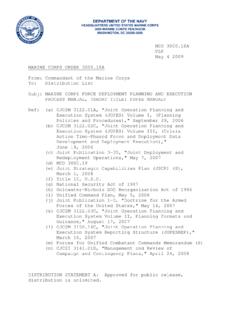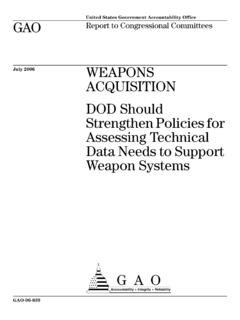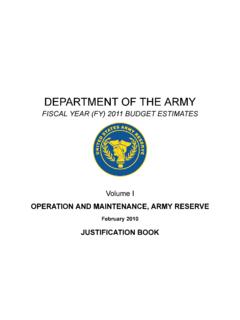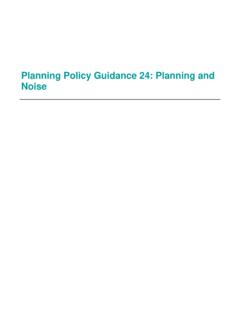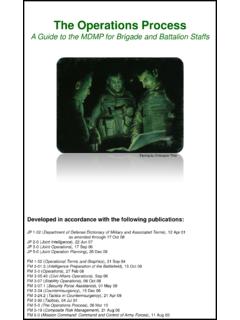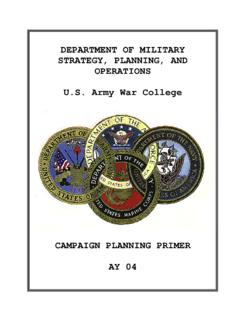Transcription of Chapter 6 Planning For Mobilization And …
1 Chapter 6 Planning For Mobilization And deployment To meet global commitments across the full spectrum of military operations, our Army has mobilized more than164,000 Reserve Component Soldiers. More than 325,000 American Soldiers are serving overseas and more than23,000 Soldiers are supporting operations within the United States. This high operating tempo is no longer anexception. Sustained operations and deployments will be the norm for our Army forces supporting multiple andsimultaneous shaping and stability operations around the globe. The United States Army 2004 Posture StatementSection IIntroduction6 1. Chapter contentThe deployment aspect of The Army Posture Statement forcefully expresses today s Army deployability Army is evaluating its ability to rapidly deploy decisive force throughout the world.
2 In view of today s complexglobal environment, the Army must remain prepared, trained and ready to deploy operationally, and to expand rapidlyand if necessary, mobilize to meet its regional and territorial responsibilities. The Army force structure must bedesigned to allow force projection with maximum combat power and support units to sustain that power. The AC andRC must provide both capabilities without the lengthy preparation periods that have been characteristic of the past. Theneed for deploying a substantial number of RC units overseas in the initial stages of a conflict underscores theimportance placed on the Army force structure.
3 The deterrent value of Mobilization resides not only in the AC and RC,but also in the preparedness to convert civilian manpower and industrial production rapidly into military power,individual replacements, and supplies. The capability of the United States to expand the active force rapidly andefficiently through Mobilization is essential in deterring potential enemies. Such a capability assures our allies of Fundamental to achieving such a capability is the coordination of Mobilization Planning with the planneddeployments for war that require 2. Chapter organizationThis Chapter covers Mobilization and deployment Planning systems.
4 Although the focus is on joint Planning systems,the participation of the Army in these systems is explained in some detail. Also discussed are the DOD objectives forimproving industrial preparedness in the and the Army industrial preparedness program. The discussion ofmobilization and deployment is presented in six sections: Planning System Description, Deliberate Planning , and Crisis Action Planning . Single-Crisis and Multiple-Crisis Procedures. Army Mobilization . Mobilization Management. Industrial Preparedness. Summary and IIPlanning system description, deliberate Planning , and crisis action planning6 3.
5 The Planning systemJoint operational Planning encompasses Planning for the full range of activities required for conducting joint operationsand includes Mobilization , deployment , and employment Planning . Joint operational Planning is conducted within theframework of the JSPS (discussed in Chapter 4) and the Joint Operation Planning and Execution System (JOPES).These systems are related to each other and to the DOD PPBE (discussed in Chapter 9). Army operational Planning toimplement joint operational Planning tasks is conducted within the framework of the AMOPES. Other service systems,similar to AMOPES, include the Navy Capabilities and Mobilization Plan (NCMP), the Marine Corps Capabilities Plan(MCP) and Marine Corps Mobilization Management Plan (MPLAN), the Air Force War and Mobilization Plan(WMP), the Coast Guard Capabilities Plan (CG CAP) and Coast Guard Logistic Support and Capabilities Plan (CGLSCP).
6 A. JSPS. The JSPS is a flexible and interactive process, and is the primary formal means by which the CJCS, incoordination with the other members of the JCS and COCOM Commanders, carries out statutory responsibilities anddischarges strategic Planning responsibilities. The JSPS is the mechanism for translating national security policy,61 How the Army Runsresource Planning guidance , and COCOM Commanders requirements into strategic guidance , force structuring objec-tives, and operations Planning guidance (Figure 6 1). The link with JOPES is through the JSCP, which provides short-term operational Planning guidance to the military Services and 6 1.
7 Joint strategic Planning systemb. Joint Strategic Capabilities Plan (JSCP). The JSCP, as the link to JOPES, provides guidance to the COCOMC ommanders and the chiefs of the Services to accomplish tasks and missions utilizing the current capabilities. It alsoapportions resources to COCOM Commanders, based on military capabilities resulting from completed program andbudget actions. Additionally, the JSCP provides a solid framework for capabilities-based military advice provided tothe President and the JOPES. JOPES provides a single, interoperable Planning and execution process, using similar policies andprocedures needed during Major Combat Operations (MCO) and in Small Scale Contingencies (SSC).
8 It also providesfor orderly and coordinated problem solving and decision-making supported by modern command, control, communica-tions, computer and intelligence (C4I) systems. Thus, it is the joint command and control system for operation planningand execution covering the full spectrum of potential threats identified through the national security Planning provides the means to respond to emerging crisis situations or transition to war through rapid, coordinatedplanning and execution. It also addresses Mobilization , deployment , employment, and sustainment mission is designed to support commanders and planners at national, theater, and supporting levels.
9 The goals of JOPESare to (1) Support the development of OPLANs, CONPLANs, functional plans, campaign plans, and the development ofoperation orders (OPORD) within time-constrained crisis situations.(2) Permit theater commanders to start, stop, or redirect military operations effectively and rapidly.(3) Support peacetime, crisis, and wartime Planning and execution.(4) Integrate Mobilization , deployment , employment, and sustainment activities.(5) Standardize policies and procedures that will be similar, in peacetime (including exercises) and crisis situations.(6) Support the rapid evaluation of military options and development of courses of action in single or multi-theaterscenarios (for example two major combat operations (MCO).)
10 (7) Exploit IT and communications technology advances. Specifically, utilization of the capabilities of the GlobalCommand and Control System (GCCS) and communications assets such as the Defense Data Network (DDN).(8) Expedite the development of military estimates of situations.(9) Ensure the dissemination and presentation of timely, accurate, and properly aggregated the Army Runs(10) Allow planners to identify resource shortfalls (personnel, transportation, materiel, forces, medical, and civilengineering services).(11) Secure information from unauthorized access, data manipulation, and data retrieval. System hardware must betempest (an unclassified term referring to technical investigations for compromising emanations from electricallyoperated information processing equipment) qualified and must be security certifiable for top secret sensitive compart-mented information (SCI).
